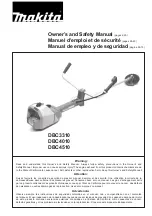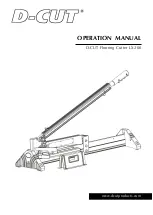
6
-
Before starting, make sure that the cutting tool has no
contact with hard objects such as branches, stones etc.
-
The engine must be switched off immediately if there are
any noticeable changes in the behaviour of the equip-
ment.
-
Should the cutting tool hit stones or other hard objects,
immediately switch off the engine and inspect the cut-
ting tool.
-
Inspect the cutting tool at freqvent intervals for damage
(detect hairline cracks by means of tapping - noise test).
Hairline cracks can occur in the region of the base of the
teeth (9) after long use. Damaged cutting tools and
cutting tools with hairline cracks must not be used
any longer under any circumstances.
-
Operate the brushcutter only with the shoulder strap
attached, which is to be suitably adjusted before putting
the brushcutter into operation (10). It is essential to
adjust the shoulder strap according to the user’s size to
prevent fatigue during use. Never hold the cutter with
one hand during use.
-
When working with the brushcutter always hold it with
both hands (10). Keep cutting attachment below waist
level. Keep proper footing and balance at all times.
-
Operate the brushcutter in such a manner as to avoid
inhalation of the exhaust gases. Do not start or operate
the brushcutter in closed rooms (risk of gas poisoning).
Carbon monoxide is an odorless gas; breathing exhaust
fumes can kill. Work only in well-ventilated places.
-
When taking a break or leaving the brushcutter unat-
tended, turn off the engine (11), make sure the cutting
attachment has stopped and set the brushcutter down in
such a way that there is no risk of injury to yourself or
others.
-
Never put the hot brushcutter onto dry grass or onto any
combustible materials.
-
Shut off the engine during transport or when moving on
to a new location (11).
-
Never operate the engine with a faulty exhaust muffler.
If the spark arrestor screen is damaged, replace it
immediately. The use of the brushcutter with a damaged
spark arrestor can cause bushfires!
Kickback
(Blade Thrust)
When operating the brushcutter, uncontrolled kickback
may occur.
This particularly the case when cutting in the area between
12 and 2 (12).
Never start a cut in this area when cutting hard ob-
jects such as brush, bushes etc.
If you do this, the brushcutter will be thrown to one side at
high speed and with great force. High risk of injury!
Never start a cut in the area between 12 and 2 (Fig. 12).
Kickback prevention (13):
-
To avoid kickbacks, observe the following:
-
Always watch what you´re doing! Be careful when
continuing cuts started previously.
-
The cutting tool must be turning at full speed before
starting cuts.
-
There is a high risk of injury in the area between 12 and
2, especially when using metal cutting blades.
-
Cuts in the areas between 11 and 12 and between 2
and 5 should be performed only by trained operators
and at their own risk.
-
Easy, low-kickback cutting is possible in the area be-
tween 8 and 11.
13
CAUTION:
Kickback!
12
9
3
6
12
CAUTION:
Kickback!
STOP
STOP
11
●
Breaks
●
Transport
●
Refuelling
●
Maintenance
●
Tool Replacement
10
9







































